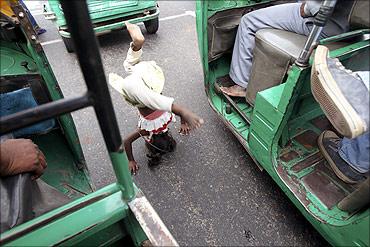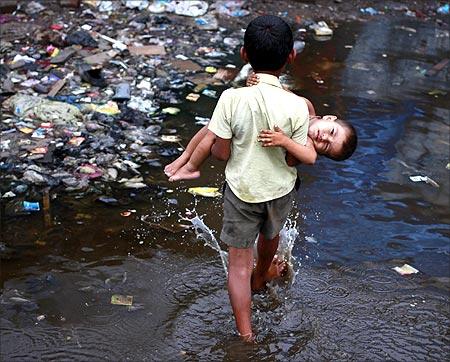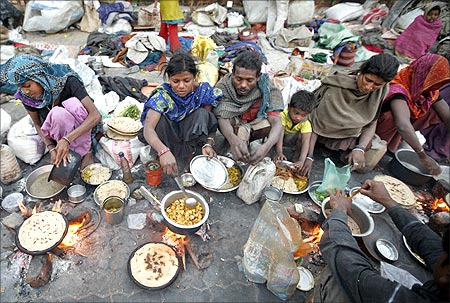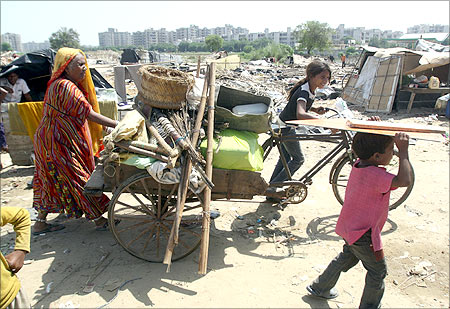
To cope with India's urban explosion, it is vital to find ways of housing the poor, writes Subir Roy.
A third of urban India and half of some metros live in slums.
In this third piece of a series (Creating affordable urban capacity, February 15; The dead end of metros and flyovers, March 28) on creating affordable urban capacity, we look at private and public action on housing.
First, what can't be done: offering shelter to the unskilled who, a step away from destitution, migrate to cities -- particularly during droughts -- in search of any kind of work.
If they found a perceptibly better life in cities then their migration would become a torrent.
To make cities liveable even as rural areas remain where they are is asking for trouble.
. . .

Now, what is being done: in recent years both private and public efforts have been made to create affordable urban housing.
In two private initiatives on the outskirts of Bengaluru, the cheapest and smallest homes (350-400 square feet) cost Rs 600,000-700,000, all told.
The smallest of these, one-room apartments, have optional car parking space.
Clearly, they are for either the entry-level techie or the schoolteacher.
For the blue-collar worker with some skills – the electrician, the plumber or the driver -- the only place to live remains the slum.
. . .

It is here that the central government has made a serious effort by initiating the Rajiv Awas Yojana -- carefully named to indicate a RAY of hope, if only as an acronym for now.
The minimum to be offered is an apartment with 25 square metres of carpet area, two rooms, a balcony, water-sealed toilet, bathroom, kitchen and drinking water -- just right for our blue-collar worker.
RAY was launched last year and was expected to cover 250 cities, with a population of more than 100,000, by the end of the 12th Plan (2012-17) as well as around 32 million slum dwellers.
. . .

In the first phase, 20 states were asked to prepare action plans to achieve 'slum-free' status, and 30 cities in 16 states were identified to implement the action plan with initial central funding.
RAY seeks to create affordable housing stock and provide civic and social amenities.
It not only wants to make cities slum-free, but also seeks to devise plans so that slums do not grow again.
It promises slum dwellers property rights over the shelters created for them.
A slum, notified or not, will become part of the same formal system as the rest of the city so that it is included in plans for basics like water supply and sewerage.
. . .

Today, they are black holes in the urban topography.
There is space for the private sector, particularly in mega cities, via devices like land-use zoning, changing the floor area ratio and introducing transferable property rights.
The public-private partnership model will be evolved to monetise concessions for allowing land use.
The viability gap funding route will also be used.
By involving slum dwellers right from the beginning, all routes will be explored -- beneficiary-built, community-based and public agency-led.
. . .

The latest technology will be used for the programme.
Geological (via satellite), socio-economic and ground-level data will be used to build a database that will power a slum information system facilitating a Web-based Management Information System application.
The data will also be used to prepare baseline reports for slums and actions plans to remove them.
Who will pay?
The Centre 50 per cent, beneficiaries 12 per cent (not exceeding 25 per cent of monthly income) and states at least 20 per cent.
. . .

Who will do the job?
The states, which will get to set the pace.
Thus, the basic question mark over the plan is: only a handful of states will have the capability (the Centre has, of course, offered all help), inclination and resources to undertake the project seriously.
To enable the programme, states must reform, pass new laws -- most importantly, to give property rights to slum dwellers -- and adopt new policies.
If state reforms required to get urban renewal mission funds are any guide, the funds will be spent but little reform will happen.
A key danger will be giving slum dwellers new apartments that they promptly sell and shift to new slums on the city periphery.
To avoid this, slum dwellers will have to take possession of the agenda for change so that they take ownership of what is created.
Then they will stay put and continue to play their useful economic role in cities.
The author is a senior fellow at the Centre for Public Policy at IIM, Bangalore, working on urban issues